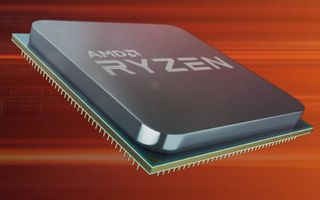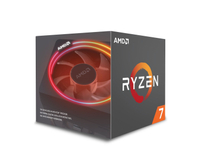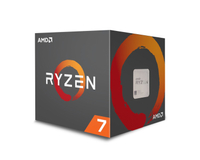AMD Announces 2nd Generation Ryzen 7 & 5 CPUs: Pricing, Pre-Orders

AMD announced that its second-generation Ryzen 7 and 5 processors, known as either the Pinnacle Ridge or the 2000-series, are available now for pre-order ahead of general availability on April 19.
The new processors mark AMD's first refresh of its Zen-based chips and come packing the Zen+ microarchitecture on the 12nm LP GlobalFoundries process, which is a shrink of the 14nm LPP node used on the current-gen Summit Ridge processors. AMD will eventually outfit its entire lineup of desktop chips with the new process, so the Pinnacle Ridge chips mark the opening salvo of a new wave of AMD processors.
| Header Cell - Column 0 | Ryzen 7 2700X | Ryzen 7 2700 | Ryzen 5 2600X | Ryzen 5 2600 | Ryzen 7 1800X | Ryzen 5 1600X | Ryzen 5 1600 | Ryzen 7 1700X | Ryzen 7 1700 |
|---|---|---|---|---|---|---|---|---|---|
| MSRP | $329 | $299 | $229 | $199 | $349 | $219 | $189 | $309 | $299 |
| Interface | 1331 | 1331 | 1331 | 1331 | 1331 | 1331 | 1331 | 1331 | 1331 |
| Process | 12nm LP GloFo | 12nm LP GloFo | 12nm LP GloFo | 12nm LP GloFo | 14nm LPP GloFo | 14nm LPP GloFo | 14nm LPP GloFo | 14nm LPP GloFo | 14nm LPP GloFo |
| Cores/Threads | 8/16 | 8/16 | 6/12 | 6/12 | 8/16 | 6/12 | 6/12 | 8/16 | 8/16 |
| TDP | 105W | 65W | 95W | 65W | 95W | 95W | 65W | 95W | 65W |
| Base Freq. GHz | 3.7 | 3.2 | 3.6 | 3.4 | 3.6 | 3.6 | 3.2 | 3.4 | 3.0 |
| All-Core Precision Boost | ? | ? | ? | ? | 3.7 | 3.7 | 3.3 | 3.5 | 3.1 |
| Precision Boost Freq (dual core) | 4.3 | 4.1 | 4.2 | 3.9 | 4.0 | 4.0 | 3.6 | 3.8 | 3.7 |
| XFR Frequency GHz | ? | ? | ? | ? | 4.1 | 4.0 | 3.7 | 3.9 | 3.8 |
| Cache (L3) | 16MB | 16MB | 16MB | 16MB | 16MB | 16MB | 16MB | 16MB | 16MB |
| Unlocked Multiplier | Yes | Yes | Yes | Yes | Yes | Yes | Yes | Yes | Yes |
| Cooler | ?W Wraith Prism (LED) | 95W Wraith Spire (LED) | 95W Wraith Spire | 65W Wraith Stealth | - | - | 95W Wraith Spire | - | 95W Wraith Spire (LED) |
AMD is announcing four new unlocked SKUs that include two Ryzen 7 models and two Ryzen 5 models. The Ryzen 7 2700 processors both come with eight cores and 16 threads, while the Ryzen 5 2600 processors come with six cores and 12 threads.
The Ryzen 7 2700X's naming suggests it is a refreshed Ryzen 7 1700X, but it appears more akin to the 1800X. One of the most noticeable improvements comes in the form of the higher base and boost frequencies. The 2700X gains an extra 100 MHz of base clock speed and 300 MHz in boost performance compared to the Ryzen 7 1800X, but it comes at the expense of a 10W increase in TDP. Interestingly, the Ryzen 5 2600X has the same base frequency as the Ryzen 5 1600X, but it comes with a 200 MHz higher boost.
| Header Cell - Column 0 | AMD Ryzen 7 2700X | AMD Ryzen 7 2700 | AMD Ryzen 5 2600X | AMD Ryzen 5 2600 | Intel Core i7-8700K | Intel Core i7-8700 | Intel Core i5-8600K | Intel Core i5-8400 | Header Cell - Column 9 |
|---|---|---|---|---|---|---|---|---|---|
| MSRP | $329 | $299 | $229 | $199 | $359 | $303 | $257 | $182 | Row 0 - Cell 9 |
| Cores/Threads | 8/16 | 8/16 | 6/12 | 6/12 | 6/12 | 6/12 | 6/6 | 6/6 | Row 1 - Cell 9 |
| TDP | 105W | 65W | 95W | 65W | 95W | 65W | 95W | 65W | Row 2 - Cell 9 |
| Base Freq. GHz | 3.7 | 3.2 | 3.6 | 3.4 | 3.7 | 3.2 | 3.6 | 2.8 | Row 3 - Cell 9 |
| Precision Boost Freq (dual core) | 4.3 | 4.1 | 4.2 | 3.9 | 4.7 | 4.6 | 4.3 | 4.0 | Row 4 - Cell 9 |
| Cache (L3) | 16MB | 16MB | 16MB | 16MB | 12MB | 12MB | 9MB | 9MB | Row 5 - Cell 9 |
| Unlocked Multiplier | Yes | Yes | Yes | Yes | Yes | No | Yes | No | Row 6 - Cell 9 |
The $329 Ryzen 7 2700X retails for $20 less than the 1800X, while the $299 Ryzen 7 2700 lands at the same price point as the 1700. The Ryzen 5 models come at a $10 premium compared to the Ryzen 5 1600X and 1600. Overall, the similar price ranges will find these processors trading blows with many of the same Intel competitors as their predecessors, but AMD added a few other extras.







The Summit Ridge Ryzen X-series processors came without bundled coolers, but AMD includes one with every new Pinnacle Ridge SKU. The Ryzen 7 models come with LED-equipped models. We don't know the TDP rating for the Wraith Prism that AMD announced at CES, but we expect it will dissipate at least 105W of waste heat to accommodate the Ryzen 7 2700X. The Ryzen 7 2700 comes with the 95W Wraith Spire, which should afford some thermal headroom for overclocking. AMD also offers Wraith Spire and Stealth coolers that match the TDP ratings for each of the updated Ryzen 5 models.
As promised, AMD will continue to support the AM4 platform until 2020. The new Pinnacle Ridge processors will drop into both 300- and 400-series motherboards, and the first-generation Ryzen processors are also cross-compatible. AMD designed a badge to alert users that some 300-series motherboards will require a BIOS update before you can use a 2000-Series processor. Eventually all the 300-series motherboards will support the Pinnacle Ridge processors out of the box.
Stay On the Cutting Edge: Get the Tom's Hardware Newsletter
Get Tom's Hardware's best news and in-depth reviews, straight to your inbox.
The X470 chipset appears to be the best choice for the new processors, though. The 400-series chipsets should be less expensive than 300-series boards. The motherboards should offer lower power consumption, multi-hub USB throughput, improved power delivery, and improvements to the memory layout to support much higher memory overclocking performance. AMD's Ryzen processors benefit greatly from increased memory frequencies because the Infinity Fabric runs at the same speed as the system memory. That boosts performance in memory-sensitive applications, like gaming.
AMD also pairs the higher clock speeds with the new Precision Boost 2, which we've covered several times. In short, Precision Boost 2 is comparable to Intel's multi-core Turbo Boost technology. Precision Boost 2 is a DVFS (Dynamic Voltage Frequency Scaling) implementation designed to improve performance in multi-threaded workloads by operating on up to eight threads. AMD's current-gen Ryzen processors only offer dual-core or all-core boost frequencies. Precision Boost 2 should help the Pinnacle Ridge processors extend the benefit of Ryzen's already-strong threaded performance to a wider variety of workloads. AMD doesn't share a list of specific multi-core Precision Boost bins because the algorithm is opportunistic and will boost to different frequencies based upon temperature, current, and load. That isn't too surprising—Intel also stopped sharing its multi-core Turbo Boost ratios for similar reasons.
We also spot a new addition to AMD's SenseMI Suite. The company touts the StoreMI technology as an intelligent storage software that boosts performance, which seems to be comparable to the FuzeDrive software the company offers as a stand-alone product for AMD platforms. The FuzeDrive software melds SSDs, HDDs, and even RAM into a single storage volume to boost performance. The software is designed to combine the low price and high capacity of an HDD with the speed of an SSD, 3D XPoint, or even system RAM, with no user interaction after the initial setup. We've covered the software in our "AMD And Enmotus Expand FuzeDrive Offerings" article.
Thoughts
Intel's Coffee Lake processors have helped the company address several of the key competitive aspects of the initial salvo of Ryzen processors, but the company's overdue 10nm process has given AMD room to respond with a refreshed lineup.
AMD's response leverages many of Ryzen's basic value propositions, such as unrestricted overclocking on all CPUs and most motherboards, less-expensive motherboards, competitive pricing, and strong multi-threaded performance. The new Precision Boost 2 feature promises to bring more of that threaded heft to diverse workloads, while the frequency improvements should help the company whittle away at Intel's advantage in lightly threaded workloads.
The official launch is just one week away, but we've already seen several reviews pop up online with X370 motherboards, even though the previous-generation motherboards are unlikely to unleash the new chips' full potential. We have seen one credible review that outlines improved Infinity Fabric and memory latency, which we've covered here. We also know from leaked reviews that both memory and Infinity Fabric latency has improved significantly, which should help the company with gaming performance.
Unlike previous pre-order windows, AMD hasn't provided any performance projections ahead of the official launch. As always, we advise readers to wait for the obviously pending reviews, but the processors are available for pre-order now.

Paul Alcorn is the Managing Editor: News and Emerging Tech for Tom's Hardware US. He also writes news and reviews on CPUs, storage, and enterprise hardware.
-
Giroro I can't decide what's more disappointing: the increased price or the increased TDP.Reply
I thought "12nm" was supposed to be a better process. But if it's not better in terms of price or heat, then you might as well overclock an 1800x - which has been steadily available at $319 for quite a while. -
SkyBill40 In my personal opinion and unless there's a truly significant difference in performance over the 1800X, I don't really see the point when you can currently get the 1800X for cheaper (though it does not come with a cooler, so there's that). Now if we were talking regular retail versus sale prices, that's something else. To that, as I'm not a very firm believer in "leaked" benchmarks, I guess I'll be waiting to see how it performs by comparison.Reply
Any word on when the new chipset boards will be available or should we expect those around the same time? -
salgado18 Reply20882489 said:I can't decide what's more disappointing: the increased price or the increased TDP.
I thought "12nm" was supposed to be a better process. But if it's not better in terms of price or heat, then you might as well overclock an 1800x - which has been steadily available at $319 for quite a while.
The increase in price comes with a very good cooler, but in general, the price increase is small. The increase in TDP comes from the improved clocks, but on the previous 14nm LPP, probably we would see something like 20W-30W increase for the same clocks, and here we have only 10W. Also, memory controller is better, and a lot has improved in other areas.
You must be disappointed because you expected 25% increase but got 15% instead. Well, they only promised 15% anyway, and delivered on that. -
Martell1977 Glad to see AMD staying in the game.Reply
However, your charts say 16mb cache while AMD's slides say the 2700X and 2700 have 20mb and the 2600X and 2600 have 19mb. -
PaulAlcorn Reply20882597 said:Glad to see AMD staying in the game.
However, your charts say 16mb cache while AMD's slides say the 2700X and 2700 have 20mb and the 2600X and 2600 have 19mb.
We're just listing the L3 cache there, each core comes with a 512KB slice of L2 cache, bringing the aggregate to 20/19.
-
Giroro Reply20882576 said:20882489 said:I can't decide what's more disappointing: the increased price or the increased TDP.
I thought "12nm" was supposed to be a better process. But if it's not better in terms of price or heat, then you might as well overclock an 1800x - which has been steadily available at $319 for quite a while.
The increase in price comes with a very good cooler, but in general, the price increase is small. The increase in TDP comes from the improved clocks, but on the previous 14nm LPP, probably we would see something like 20W-30W increase for the same clocks, and here we have only 10W. Also, memory controller is better, and a lot has improved in other areas.
You must be disappointed because you expected 25% increase but got 15% instead. Well, they only promised 15% anyway, and delivered on that.
I assume you are saying I must be disappointed because the increase (in performance?) is too low, but there no information on performance here. I am complaining about a price hike, combined with disappointment that 12nm does not actually appear to increase efficiency (or possibly die density) over 14nm.
The architecture improvements in Ryzen 2 seem very minor, especially when slight bumps to base frequency and XFR don't actually help to anyone who would overclock Ryzen - which I imagine is most people reading this.
Maybe AMD knows something we don't and Ryzen 2 overclocks way better than Ryzen 1 or something. It does look like you are paying ~10% more for a processor with ~10% faster clocks (including memory) that gets ~10% hotter. So it feels more like you're paying for a factory overclock of the last-gen instead of a real iteration, which is fine I guess .. but not exactly going to win over many of the people who were waiting to hear about Ryzen 2 before going forward with their Intel build.
Most Popular










